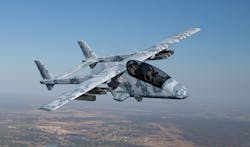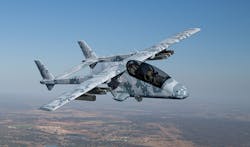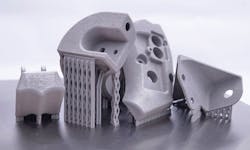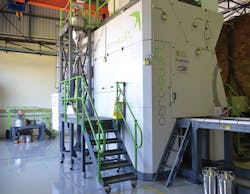Project to industrialize powder bed fusion technology for aerospace component manufacturing
PETER MIDDLETON
Hardus Greyling of South Africa’s Council for Scientific and Industrial Research (CSIR; Pretoria, South Africa) and Marius Vermeulen from Aerosud Innovation and Training give an insight into the R&D project Aeroswift. The project involves the development of one of the largest laser-based additive manufacturing machines in the world, and it is used to define and industrialize powder bed fusion (PBF) technology for the manufacture of high-value aerospace and other components.
Large-scale powder bed fusion AM system
Through an R&D collaboration between aerospace company Aerosud Innovation Centre (IC; also in Pretoria) and CSIR, Aeroswift was established to advance laser additive manufacturing technology in South Africa. “The official program started in 2011 with funding from our Department of Science and Technology (DST) and the R&D partners,” Vermeulen says.
“At the heart of the program is to better beneficiate South Africa’s titanium resources, along with supporting an emerging high-value component manufacturing industry, locally and abroad,” he continues.
“We have been developing laser and additive manufacturing capabilities for many years at the CSIR,” Greyling adds. “We are currently commercializing direct energy deposition/laser metal deposition (DED/LMD) technology for weld repair applications in industry, including work for our local power utility, ESKOM. This system is designed to be mobile, so that repairs can be undertaken onsite such as repairing large power station components,” he continues.
FIGURE 1. Aerosud IC is key partner in the development of the AHRLAC aircraft.
Aerosud IC is key partner in the development of AHRLAC, an advanced, high-performance reconnaissance light aircraft designed as a versatile, rugged, multi-role manned platform (FIGURE 1). “To achieve lowest possible weight and extended component life, AHRLAC was designed with additive manufacturing in mind and, with the Aeroswift powder bed fusion system we have developed, we have already started manufacturing commercial parts for the AHRLAC: the throttle grips, the engine condition lever grip, and some titanium ducting components,” Vermeulen says (FIGURE 2).
FIGURE 2. The Aeroswift powder bed fusion system is being used to manufacture the throttle grips, engine condition lever grip, and some titanium ducting components for the AHRLAC aircraft.
Aeroswift, Vermeulen continues, is an R&D laser additive manufacturing platform that also serves as a prototype. “Ultimately, we aim to design purpose-built laser additive manufacturing machines to suit target applications—and while we are currently focused on titanium, this is not a machine limitation,” he explains.
The powder bed fusion (PBF) system
The Aeroswift machine was designed to use large powder volumes, up to 2000 × 600 × 600 mm, typically for manufacturing large aerospace components or batches of smaller components in titanium (FIGURE 3). “Aerospace is a business involving low-volume, high-value, and high-integrity applications, and additive manufacturing is ideal for supplying this industry’s needs,” Vermeulen says.
FIGURE 3. The Aeroswift machine uses large powder volumes for manufacturing large aerospace components or batches of smaller components in titanium.
The Aeroswift machine itself was designed, developed, and constructed from the ground up, focusing on the mechanical and optical systems, and includes some commercially available sub-components, either directly or following adaptations to suit the purpose.
“The size of this machine makes this project particularly exciting. The powder bed is bigger than any commercially available technology and, while we know that other manufacturers are currently launching big machines, to our knowledge, ours currently has the largest build volume in the world,” Vermeulen says. “We are also using a very high-power laser: a 5 kW IPG [IPG Photonics] fiber laser in order to increase the production rate and reduce the costs,” he adds.
The build volume was designed for full adjustability with a movable bed, enabling any build length to be accommodated. Via the control system, every parameter involved in the build process can also be finely tuned: the laser spot size and power; the mirror scan rates and mechanical manipulator speeds; the powder feed rates; the overlap between adjacent laser tracks; the layer thicknesses, patterns and strategies; and the laser processing and shielding gas compositions. “Our controller gives us the flexibility to control and optimize every individual parameter,” Greyling notes.
Because of the high cooling rates involved, titanium parts made using additive manufacturing often have a quenched, fine-grained, martensitic-type microstructure. This gives very good tensile properties, but poor elongation and toughness properties. “Generally, if the component properties need to match those of a wrought billet, we need to carry out an annealing heat treatment to soften the structure and to allow grain growth,” Greyling says.
“Overall, the idea is to optimize the processing parameters to achieve best possible material properties at high production rates, which is exactly what the aerospace industry needs,” Vermeulen adds.
Titanium, South Africa, and aerospace
South Africa has the second largest reserves of titanium deposits in the world, but titanium metal is not being locally produced. CSIR is looking at making metal from local ores, but is trying to avoid using the traditional and energy-intensive Kroll process by making powder from titanium tetrachloride.
“The powder being manufactured at the CSIR’s pilot facility is not yet suitable for us, because we need a spheroidized titanium alloy. But once this next step has been implemented, we see a supply chain going from local ores to spheroidized powder and, through additive manufacturing systems such as Aeroswift, into making titanium components,” Vermeulen says.
“If you ask why titanium has become so important in aerospace, we need to look back to about 20 years ago, when most aircraft were made in aluminum—95% aluminum and 5% other materials. These days, the likes of the Boeing 787 and the Airbus 350 are using in excess of 50% carbon fiber—and if carbon and aluminum are put together, the battery effect results in galvanic corrosion,” he explains.
Titanium is an ideal replacement for aluminum, as it is chemically inert because of its passive oxide layer on the material surface. Up to 14% of the material used in these new aircraft is now titanium, with the aluminum content being proportionally lower. In addition, titanium has an excellent strength-to-weight ratio and offers superior performance at high temperatures.
However, it is an expensive material and difficult to manufacture using traditional techniques. During casting, titanium is very reactive and sensitive to oxygen and mold materials. And when cold, it is a very tough material to machine and heavy on tools. Consequently, finished parts become very expensive.
“That is why the modern aerospace industry and additive manufacturers are meeting one another. Additive manufacturing offers easier manufacturing that is unencumbered by process limitations of the past. There is less waste, much less machining, and it makes a huge amount of sense when designing for weight reduction,” Vermeulen comments.
Part number reduction is also a key driver towards additive manufacturing: on a newly developed advanced turboprop engine from GE Aviation, for example, 855 parts were replaced with 12, resulting in lower assembly costs and lower operating costs with respect to inspection, handling, storage, and supply. The engine, which is planned for use on Cessna and other small aircraft, is also lighter and more efficient, owing to the adoption of additive manufacturing for 30% of the components.
Another example is the 3D-printed fuel nozzle for the new LEAP Jet Engine from GE, where 20 conventionally manufactured parts are now manufactured as a single unit by adopting additive manufacturing.
From a cost perspective, Vermeulen says that costs per part are coming down fast: “With the larger platform of the Aeroswift, the higher-power laser, and the faster scanning available from the mirrors and reflectors, the machine is 6–10X faster than currently available commercial systems. This brings costs per part down to one third of those being commercially quoted. And these costs are sure to drop as we downscale machines to match specific component requirements and cost scenarios.”
If South Africa can start producing lower-cost titanium, we could be sitting with a global edge with respect to powder bed fusion technology. The potential is already big, and it is going to get even bigger,” Vermeulen believes. ✺
PETER MIDDLETON ([email protected]) manages, edits, and writes for MechChem Africa (www.crown.co.za/mechchem-africa), a general industry journal, and African Fusion, the journal of the Southern African Institute of Welding.
Editor’s note: This article was reprinted from The Laser User, Issue 88 (Spring 2018), with permission from the author and the Association of Laser Users; www.ailu.org.uk. It was selected by ILS to further global industry knowledge of laser additive manufacturing advances being made in South Africa.



